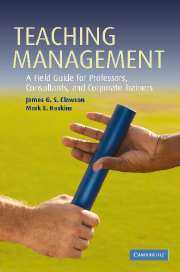Book contents
- Frontmatter
- Contents
- List of figures
- Sources to chapter quotations
- Why this book on teaching management?
- 1 Fundamental elements in teaching
- 2 Levels of learning: one, two, and three
- 3 Adult learning theory: it matters
- 4 Planning a course: trips and tips
- 5 Planning a class: no detail is too small
- 6 Lecturing: the possibilities and the perils
- 7 Managing discussions
- 8 Case method: fostering multidimensional learning
- 9 Role-playing
- 10 Case writing: crafting a vehicle of interest and impact
- 11 Case teaching notes: getting from here to there
- 12 Action learning
- 13 Experiential methods
- 14 Enhancing the conversation: audiovisual tools and techniques
- 15 Executive education: contributing to organizational competitive advantage
- 16 Using technology to teach management
- 17 Counseling students
- 18 Evaluating students: the twin tasks of certification and development
- 19 Teaching evaluations: feedback that can help and hurt
- 20 Research presentations
- 21 Managing a degree program: behind the ‘glory’
- 22 Managing a nondegree client program: an overview
- 23 Dealing with the press
- 24 Managing yourself and your time
- 25 Using teaching portfolios and course portfolios
- 26 Conclusion: is this on the exam?
- Index
8 - Case method: fostering multidimensional learning
Published online by Cambridge University Press: 25 February 2010
- Frontmatter
- Contents
- List of figures
- Sources to chapter quotations
- Why this book on teaching management?
- 1 Fundamental elements in teaching
- 2 Levels of learning: one, two, and three
- 3 Adult learning theory: it matters
- 4 Planning a course: trips and tips
- 5 Planning a class: no detail is too small
- 6 Lecturing: the possibilities and the perils
- 7 Managing discussions
- 8 Case method: fostering multidimensional learning
- 9 Role-playing
- 10 Case writing: crafting a vehicle of interest and impact
- 11 Case teaching notes: getting from here to there
- 12 Action learning
- 13 Experiential methods
- 14 Enhancing the conversation: audiovisual tools and techniques
- 15 Executive education: contributing to organizational competitive advantage
- 16 Using technology to teach management
- 17 Counseling students
- 18 Evaluating students: the twin tasks of certification and development
- 19 Teaching evaluations: feedback that can help and hurt
- 20 Research presentations
- 21 Managing a degree program: behind the ‘glory’
- 22 Managing a nondegree client program: an overview
- 23 Dealing with the press
- 24 Managing yourself and your time
- 25 Using teaching portfolios and course portfolios
- 26 Conclusion: is this on the exam?
- Index
Summary
Thinking is the mind talking to itself.
– PlatoIt can be said flatly that the mere act of listening to wise statements and sound advice does little for anyone. In the process of learning, the learner's dynamic cooperation is required. Such cooperation from students does not arise automatically, however. It has to be provided for and continually encouraged.
– Charles I. GraggCase method refers to instruction that utilizes descriptions of actual situations to provide a basis for discussion among students and instructor. These descriptions are usually written, but they may be oral, videotape, CD-ROM, or Web-based. The underlying intent of the case method is to narrow the gap between theory and practice by placing students in the midst of a real situation they are likely to encounter, then to press them to analyze the situation, make a decision regarding a course of action to take, and then defend that decision in the midst of their peers. Cases were first used in medical instruction, then in law. The approach was adapted for use in business instruction early in the twentieth century (see Garvin, 2003).
In a typical case-method course, students are given a written case in advance of each class. The case may or may not be accompanied by an additional reading requirement that introduces a theory or an analytical framework that the students can apply to the case. Sometimes, the instructor will present the theory in lectures either before, during, or after the case discussion.
- Type
- Chapter
- Information
- Teaching ManagementA Field Guide for Professors, Consultants, and Corporate Trainers, pp. 119 - 140Publisher: Cambridge University PressPrint publication year: 2006
- 2
- Cited by



